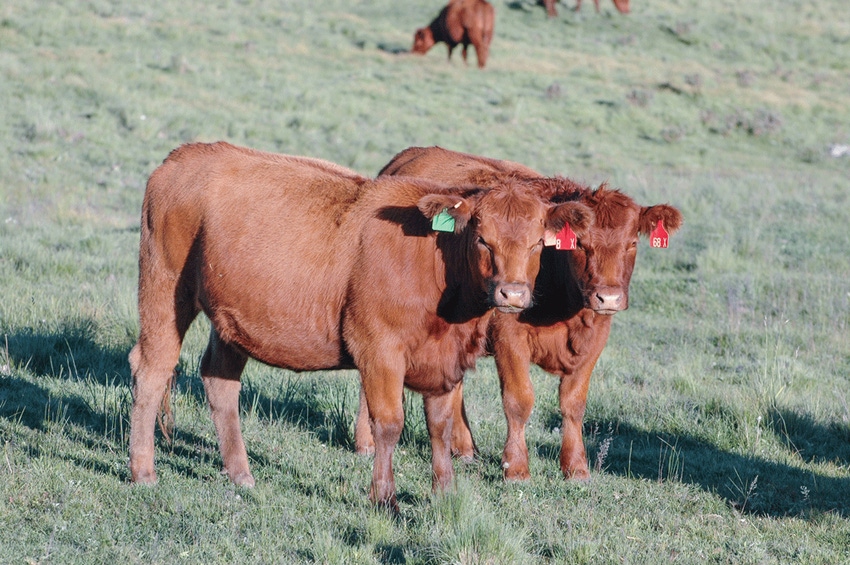Effective target weight for heifers depends on cattle, environment and management.
February 8, 2016

Heifers can be developed to lighter target weights than the traditional 65% of mature weight by the first day of breeding season without sacrificing reproductive efficiency or longevity. But, it depends on the heifers, the environment and nutritional management during and after breeding season.
“If you have a crossbred herd comprised of early-maturing breeds, moderate-framed cows and a large herd, you’re able to pick from a lot of heifers for replacements — and if you live in a limited-resource environment, then managing heifers to achieve 55% of their mature body weight by the first day of breeding season might be the way to go,” says John Hall, Extension beef specialist at the University of Idaho. He’s also superintendent of the Nancy M. Cummings Research, Extension and Education Center near Salmon.
On the other hand, Hall explains, “If you have a herd of limited numbers with larger-framed cows of later-maturing breeds, purebred or straightbred, then managing for 65% of mature body weight probably makes the most sense.”
The weight debate
After all, the longstanding 65% target is based on sound science, experience and common sense.
Rather than selecting faster-growing, heavier heifers at weaning — indirectly selecting for larger mature size — or growing heifers faster and quicker with higher-energy rations — leading to precocious puberty — industry focus turned to using target weights as a percentage of expected mature weight as a guide.

John Hall
“Across lightweight and heavyweight heifers, and across a broad range of breeds and a wide variety of environments, 65% results in very positive pregnancy rates for heifers,” Hall explains.
In some cases, the smaller size of heifers developed to lighter target weights, depending on how they’re developed postbreeding, can result in calving problems. In the case of larger-framed heifers held to lighter target weights, Hall explains, “They can have poor reproductive performance, because we aren’t getting heifers big enough for their mature size. If we severely restrict those kinds of heifers during the postweaning period, not only may we not get many heifers bred, but a greater percentage of them can have trouble maintaining pregnancy.”
Developing heifers to the 65% target costs plenty, though, especially considering the need for supplementation in many instances, and the cost of delivering it effectively in extensively managed operations.
That’s one reason why some producers and researchers began wondering if the target is excessive.
Rick Funston, a beef reproduction physiologist at the University of Nebraska’s (UN) West Central Research and Extension Center at North Platte, and his team were among those asking the question. In research trials a decade or so ago, they began demonstrating that in commercial conditions, heifers can be managed to a target weight of 55% without sacrificing conception rates or longevity in the herd, and could be developed for significantly less cost.
“Several studies [UN and others] have clearly shown that managing heifers to reach 55% of mature weight by the beginning of the breeding season does not reduce the percentage of heifers becoming pregnant in the first 21 days of the breeding season, compared to heifers fed to a greater target weight,” Hall explains. “However, to ensure acceptable pregnancy rates and proper size for calving, heifers still need to achieve 90% of their mature weight before calving,” he says.
“After the breeding season, heifers developed to a 55% target need to continue to gain weight at a more rapid rate than heifers developed to a 65% target,” Hall says, and they need to continue to gain weight following the breeding season.
Hall also points out a majority of research concerning the 55% target weight has been conducted with crossbred or composite cattle. Due to heterosis, he explains, these cattle reach puberty at a younger age than the purebred or straightbred breeds comprising them.
“Using the 55% target weight will be fine for some operations, but not for others,” Hall says.
Timing matters, too
Whatever the target, Hall emphasizes, “A pregnant heifer is not the same as an early-pregnant heifer. Too often, we talk about getting 80% of the heifers pregnant, but that might be within a 45-day or 60-day breeding season. There are distinct advantages to heifers that calve in the first 21 days of their initial calving season.”
For one thing, various research shows that heifers calving in the first 21 days consistently wean heavier calves than those that don’t. At least as important, heifers calving in the first 21 days are significantly more likely to remain in the cow herd.
Hall uses research from the U.S. Meat Animal Research Center as an example. “When we get to about the fourth calving season, about 50% of the heifers bred in the first 21 days of their initial breeding season are still in the herd,” he explains. “At the same time, fewer than 30% of the heifers bred after the first 21 days of their initial breeding season are still in the herd.”
Given the cost of developing a heifer into a productive cow, that’s no small matter to consider as you make your 2016 management plans.
You might also like:
Wendy's addresses antibiotic use in beef production
9 new pickups for the ranch in 2016
3 steps for preparing for farm economy downturn
Is production efficiency the answer to falling cattle prices?
What's ahead for the beef industry in 2016? 10 megatrends to watch
15 best winter on the ranch photos
Calving Checklist: Everything you need to know & have before calving
About the Author(s)
You May Also Like





